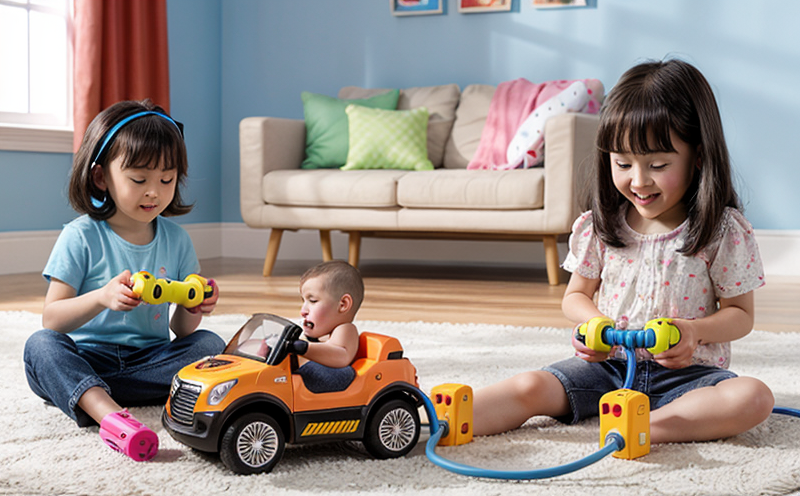ASTM F963 Electrical Safety of Toys Evaluation
The ASTM F963 standard provides comprehensive guidelines and requirements to ensure that toys are safe for children. Among its many provisions, it includes detailed specifications for evaluating the electrical safety of toys. This service focuses specifically on the ASTM F963 criteria aimed at assessing the electrical components within toys, ensuring they do not pose a risk to young users.
The evaluation process involves several critical steps that ensure compliance with the standard's rigorous requirements. The primary objective is to prevent potential hazards from electrical parts of toys such as batteries, chargers, and electronic circuits. This includes testing for insulation integrity, overcurrent protection, and ensuring proper grounding. These elements are crucial in safeguarding children’s health and preventing accidents.
The ASTM F963 standard is widely recognized by regulatory bodies around the world and is a key component of toy safety regulations in many countries. Compliance with this standard not only ensures product safety but also helps manufacturers avoid legal issues, recalls, and damage to their reputation. By adhering to these stringent guidelines, businesses can demonstrate their commitment to quality and protect consumers.
The evaluation process typically begins with the selection of appropriate test specimens based on the intended age group of the toy. This step ensures that the testing accurately reflects real-world usage conditions. Next, various electrical parameters are measured using specialized equipment designed for this purpose. These include voltage levels, current flow, and insulation resistance.
One of the most critical aspects of ASTM F963 compliance is ensuring that toys have adequate overcurrent protection mechanisms. This prevents excessive current from flowing through circuits or components when there is a fault condition. Overcurrent protection can be implemented via fuses, circuit breakers, or other similar devices. During testing, these protective features are subjected to simulated fault conditions to verify their effectiveness.
Another important consideration in ASTM F963 evaluation is the integrity of electrical insulation within toys. Insulation plays a vital role in preventing electrical shocks and short circuits. For this reason, samples undergo thorough inspection for any signs of damage or degradation that could compromise safety. If issues are identified during testing, corrective actions must be taken before retesting.
The results from ASTM F963 evaluation play an essential role not only in meeting regulatory requirements but also in enhancing product design and performance. Manufacturers can use these findings to identify areas for improvement and implement changes that enhance overall safety without compromising functionality or user experience.
| Electrical Parameter | Description | Testing Method |
|---|---|---|
| Voltage Levels | The maximum allowable voltage output from the toy's power source. | DC circuit testing using a multimeter. |
| Current Flow | The amount of current that can flow through circuits within the toy under normal operating conditions. | Ampere meter measurement during simulated operation. |
| Insulation Resistance | The resistance offered by insulating materials used in the toy against electrical leakage. | Ohm-meter testing with a specified voltage applied. |
In conclusion, ASTM F963 evaluation is an indispensable tool for manufacturers seeking to produce safe and compliant toys. By following this standardized procedure, companies can ensure their products meet the highest safety standards and comply with relevant regulations globally.
Industry Applications
| Industry Sector | Application Scope |
|---|---|
| Toys & Games | Evaluating the electrical safety of toys designed for children. |
| Children's Products | Assuring that products intended for use by minors are free from electrical hazards. |
| Consumer Electronics | Determining if electronic components within toys meet safety standards. |
The ASTM F963 standard finds extensive application across various industries where there is a need to ensure the safety of electrical toys and related products. This includes not only traditional toy manufacturers but also companies involved in designing and producing consumer electronics intended for children's use. By adhering to these stringent regulations, businesses can protect themselves against potential risks while simultaneously enhancing public trust.
Why Choose This Test
- Comprehensive coverage of electrical safety requirements outlined by ASTM F963.
- Accurate identification and mitigation of potential electrical hazards in toys.
- Facilitation of compliance with international toy safety regulations.
- Enhancement of product reputation through adherence to stringent standards.
- Reduction in the risk of product recalls due to non-compliance issues.
- Support for ongoing product improvement initiatives based on test results.
Selecting ASTM F963 evaluation ensures that toy manufacturers and developers meet essential safety criteria. This proactive approach helps protect both consumers and producers by eliminating risks associated with faulty electrical components. Additionally, it allows companies to stay ahead of regulatory changes and maintain a competitive edge in the marketplace.
Use Cases and Application Examples
| Toy Type | Evaluation Focus |
|---|---|
| Battery Operated Toys | Assessment of battery life, charging safety, and protection against overcharging. |
| Electronic Toys | Detection of potential short circuits in electronic components and ensuring proper grounding. |
| Remote Controlled Vehicles | Evaluation of remote control signals for interference with other electronic devices. |
The ASTM F963 evaluation process applies to a wide range of toys, each presenting unique challenges and opportunities for thorough assessment. For instance, battery-operated toys require careful examination of their power sources to ensure they operate safely without causing harm. Similarly, electronic toys demand attention to detail regarding circuit design and component placement to prevent accidental short circuits.
Remote-controlled vehicles offer another area where ASTM F963 evaluation proves beneficial. Ensuring that remote control signals do not interfere with other nearby electronic devices is crucial for maintaining product functionality while avoiding disruptions caused by electromagnetic interference (EMI).





